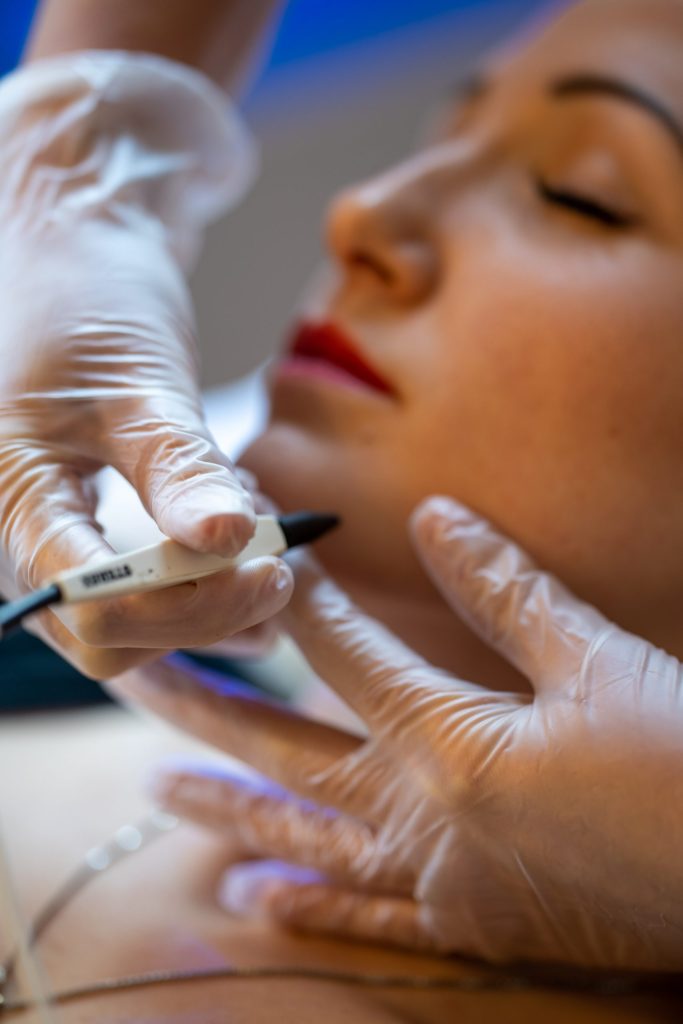Pigmentation FAQs
The best options available to lighten existing pigmentation are:
Chemical peels
IPL
Laser resurfacing
Medical/cosmeceutical grade skincare
No, there is no cure for pigmentation. There are treatments available to lighten pigmentation and remove pigmentation from the surface of the skin, but if you don’t get control of the pigment producing cells, the pigmentation will continue to return. For long term control of pigmentation a pigment regulator (also known as a tyrosinase inhibitor) and a high factor, broad spectrum SPF must be used daily to control the pigment producing cells, and sun exposure must be kept to an absolute minimum.
There are 4 different types of pigmentation and each one has different potential causes:
Sun damage – Most common cause of pigmentation which occurs due to UV damage caused by sun exposure. It appears as random brown patches on skin
Freckles – Form of genetic pigmentation seen mostly in lighter skin types. Asian and darker skin types can be more susceptible to darker patches of pigmentation, especially around the eyes
Post inflammatory hyperpigmentation (PIH) – More common in darker skin types but is not limited to them. This pigmentation develops as a result of trauma e.g. you burn yourself and the skin’s natural response is to create pigment to protect itself from further damage
Melasma – Larger patches of pigment typically seen in a butterfly pattern across the t-zone and cheeks. It is most commonly a result of hormonal imbalances; many women develop it during or post pregnancy. It can also be caused by some medications
No, there is no cure for pigmentation. There are treatments available to lighten pigmentation and remove pigmentation from the surface of the skin, but if you don’t get control of the pigment producing cells, the pigmentation will continue to return. For long term control of pigmentation a pigment regulator (also known as a tyrosinase inhibitor) and a high factor, broad spectrum SPF must be used daily to control the pigment producing cells, and sun exposure must be kept to an absolute minimum. With continued sun exposure pigmentation will continue to get worse.
Sun damage – Most common cause of pigmentation which occurs due to UV damage caused by sun exposure. It appears as random brown patches on skin
Freckles – Form of genetic pigmentation seen mostly in lighter skin types. Asian and darker skin types can be more susceptible to darker patches of pigmentation, especially around the eyes
Post inflammatory hyperpigmentation (PIH) – More common in darker skin types but is not limited to them. This pigmentation develops as a result of trauma e.g. you burn yourself and the skin’s natural response is to create pigment to protect itself from further damage
Melasma – Larger patches of pigment typically seen in a butterfly pattern across the t-zone and cheeks. It is most commonly a result of hormonal imbalances; many women develop it during or post pregnancy. It can also be caused by some medications
Hyperpigmentation is the result of an uneven distribution of melanin, which can’t harm you. It appears as a small patch that is darker than the surrounding skin. On the other hand, skin cancer is often the result of damage that has manifested into cancerous cells, and will usually appear as a distinct mole or freckle. If you’re concerned, always consult with your GP.
Hyperpigmentation is the result of an uneven distribution of melanin, which can’t harm you. It appears as a small patch that is darker than the surrounding skin. On the other hand, skin cancer is often the result of damage that has manifested into cancerous cells, and will usually appear as a distinct mole or freckle. If you’re concerned, always consult with your GP.
Genetics can play a part in some forms of pigmentation, for example freckles are a genetic form of pigmentation. In darker skin types, uneven pigmentation can also be genetic, however lifestyle can also play a big part due to many people with darker skin types assuming that they are not at risk of sun damage and therefore do not apply SPF daily.
Sun exposure – it is imperative to limit sun exposure and use a high factor, broad spectrum SPF daily to prevent pigmentation for getting worse
Medication – some medication can lead to pigmentation including; non-steroidal anti-inflammatory drugs (NSAIDs), phenytoin, antimalarials, amiodarone, antipsychotic drugs, cytotoxic drugs, tetracyclines, and heavy metals
Hormones – many women will find that they develop pigmentation during or after pregnancy due to the fluctuation in hormones
Using the wrong products – using very potent retinoids and not protecting the skin from sun exposure while it is delicate can lead to post inflammatory hyperpigmentation developing
The Cosmelan procedure is the world’s leading professional pigmentation removal method. The treatment is suitable for all forms of hyperpigmentation from melasma, post inflammatory hyperpigmentation, solar lentigo to ephelides (freckles) and can be used safely on all skin colours.
Pigment regulators (also known as tyrosinase inhibitors) and a high factor, broad spectrum SPF must be used daily to control the pigment producing cells (melanocytes). Sun exposure must be kept to an absolute minimum. With continued sun exposure pigmentation will continue to get worse.
Do use a high factor, broad spectrum SPF everyday (it’s not enough to be in another product or in your makeup). 80% of damaging UV rays penetrate through clouds so you must use SPF even on cloudy days
Do use a pigment regulator to control pigment producing cells
Do wear a hat on sunny days
Don’t use sun beds
Don’t lie in the sun
Don’t think that you will not get sun damage if your skin doesn’t burn
To protect itself from the damaging effects of the sun, your skin increases its production of melanin (this gives your skin its colour). The extra melanin makes your skin look darker or sun-tanned. Sometimes the sun causes an uneven increase in melanin production, which produces the irregular colouring (pigmentation).
Melasma is defined by large patches of pigment typically seen in a butterfly pattern across the t-zone and cheeks. It is most commonly a result of hormonal imbalances; many women develop it during or post pregnancy. It can also be caused by some medications.
Post inflammatory hyperpigmentation (PIH) is most common in darker skin types but is not limited to them. This pigmentation develops as a result of trauma e.g. you burn yourself and the skin’s natural response is to create pigment to protect itself from sun damage.
Pigmentation is characterised by uneven dark patches of skin tone. It can affect both men and women of all skin colours and vary in severity. Pigmentation forms when the melanocyte (pigment producing) cells are damaged or overstimulated and produce more melanin (pigmentation) in particular areas of the skin rather than distributing it evenly and giving you an even skin tone. There are several types of pigmentation and causes.
Chemical peels
IPL
Laser resurfacing
Medical/cosmeceutical grade skincare
Use a high factor, broad spectrum SPF everyday (it’s not enough to be in another product or in your makeup). 80% of damaging UV rays penetrate through clouds so you must use SPF even on cloudy days
Use a pigment regulator to control pigment production in the skin
Use antioxidants such as vitamin C and vitamin A in your skincare routine
Wear a hat and sunglasses when out on sunny days
Avoid using sun beds and lying in the sun without sun protection
Don’t think that you will not get sun damage if your skin doesn’t burn, pigmentation can happen appen
Prices will vary based upon your location, the quality of the products being used and the experience of your practitioner. Head to our price list to see pricing of our depigmentation and cosmelan treatments which are the most commonly recommended treatments for pigmentation.






